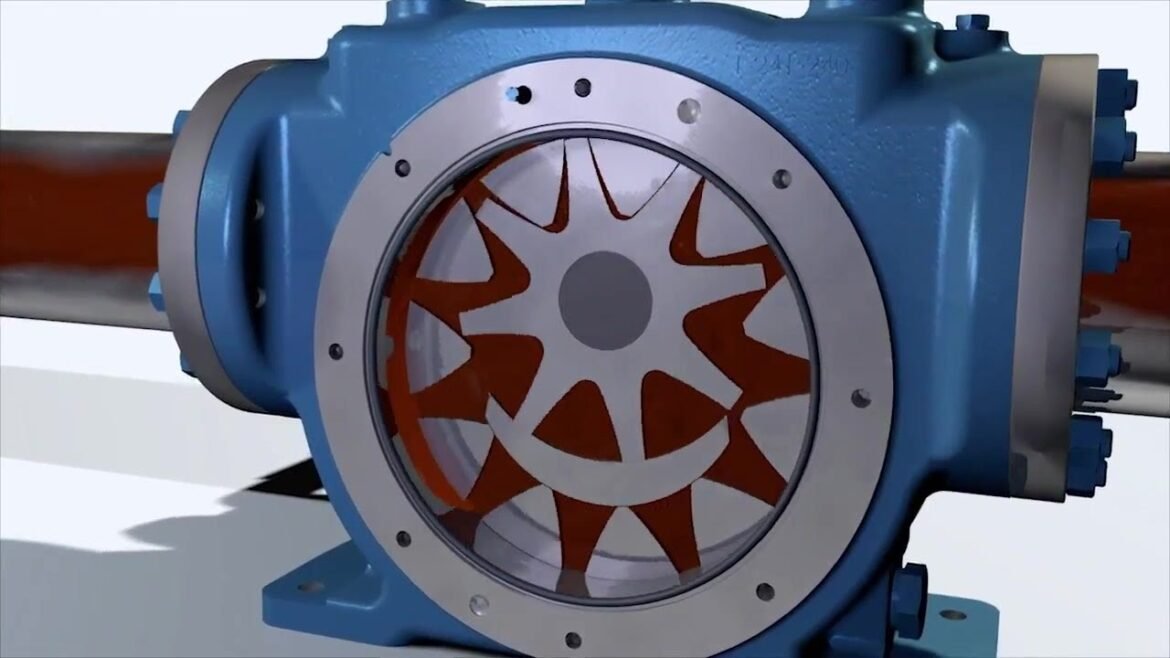Gear pumps are essential components in many mechanical systems, known for their reliability and efficiency in transferring fluids. These pumps use the meshing of gears to move fluids and are widely used in various industries, including automotive, manufacturing, and hydraulic systems. Their simplicity and durability make them a popular choice for tasks requiring consistent and precise fluid flow.
In everyday applications, gear pumps can be found in everything from oil and fuel systems to hydraulic machinery. Their ability to handle a range of viscosities and pressures while maintaining a steady flow rate is key to their widespread use. This guide will explore the different types of gear pumps, their components, and how they work, along with their advantages and disadvantages, and provide tips for maintenance and selection.
What is a Gear Pump?
Definition and Basic Concept
A gear pump is a type of positive displacement pump that moves fluid by trapping it between the gears and the pump casing. When the gears rotate, they create a vacuum that draws in fluid and pushes it out through the pump’s discharge port. The basic design involves two gears, known as the driving and driven gears, which mesh together to form a sealed chamber that moves the fluid.
This simple yet effective mechanism ensures a continuous and steady flow of fluid, making gear pumps ideal for applications where a consistent flow rate is crucial. Their design also allows them to handle a wide range of fluids, including thick, viscous substances, which can be challenging for other types of pumps.
How Gear Pumps Work
Gear pumps operate on a straightforward principle. The rotating gears create a suction effect that draws fluid into the pump chamber. As the gears continue to rotate, they force the fluid through the pump’s discharge port. The gear teeth mesh tightly to ensure that the fluid is moved efficiently and without significant leakage.
The gears’ rotation is driven by a motor or engine, which ensures a steady and consistent flow of fluid. Gear pumps are designed to handle various pressures and flow rates, making them versatile for many applications. Their efficiency is attributed to their ability to maintain a constant flow rate regardless of changes in the system’s pressure.
Types of Gear Pumps
External Gear Pumps
External gear pumps feature two gears that are positioned outside of each other, with one gear driving the other. The gears mesh together within a casing, creating a sealed chamber that traps and moves the fluid. These pumps are known for their reliability and are commonly used in applications where precise fluid delivery is required.
External gear pumps are favored for their simple design and ease of maintenance. They can handle a wide range of fluids and pressures, making them suitable for various industrial and automotive applications. Their robust design also allows them to perform well in demanding conditions.
Internal Gear Pumps
Internal gear pumps have a unique design where one gear is positioned inside the other. The inner gear rotates and meshes with the outer gear, creating a sealed chamber that moves the fluid. This design allows for a smooth and efficient transfer of fluid, making internal gear pumps ideal for handling viscous fluids.
Internal gear pumps are known for their quiet operation and ability to handle high pressures. They are often used in hydraulic systems and applications requiring precise control of fluid flow. Their design also allows them to handle a wide range of fluid viscosities.
Gerotor Pumps
Gerotor pumps are a variation of gear pumps that use a rotor within a rotor mechanism to move fluid. The design features an outer rotor with an inner rotor that rotates eccentrically. This creates a series of expanding and contracting chambers that move the fluid efficiently.
Gerotor pumps are valued for their compact size and high efficiency. They are commonly used in automotive and aerospace applications where space is limited, and precise fluid delivery is required. Their design allows them to operate smoothly and quietly while handling various fluids.
Key Components of Gear Pumps
Gears
The gears in a gear pump are crucial for its operation. They are responsible for trapping and moving the fluid through the pump. The gear teeth must be precisely manufactured to ensure a tight seal and efficient fluid transfer. The materials used for the gears are selected based on the type of fluid being pumped and the operating conditions.
Gears come in various sizes and configurations, depending on the pump’s design and application. Their durability and ability to withstand high pressures and temperatures are essential for the pump’s overall performance. Regular inspection and maintenance of the gears are necessary to ensure optimal operation.
Housing
The housing of a gear pump encases the gears and provides support for their operation. It is designed to contain the fluid and direct its flow through the pump. The housing material must be resistant to corrosion and wear, as it comes into contact with the fluid being pumped.
The design of the housing also affects the pump’s efficiency and performance. It must be precisely engineered to ensure that the gears mesh correctly and that the fluid is moved efficiently. Any damage or wear to the housing can impact the pump’s operation and lead to leaks or reduced performance.
Shafts
The shafts in a gear pump connect the gears to the motor or engine that drives their rotation. They must be robust and capable of withstanding the forces generated by the rotating gears. The shafts are typically made from high-strength materials to ensure durability and reliability.
Proper alignment of the shafts is crucial for the pump’s operation. Misalignment can lead to excessive wear, noise, and reduced efficiency. Regular maintenance and alignment checks are necessary to ensure that the shafts and gears operate smoothly.
Bearings
Bearings support the rotating shafts and gears, reducing friction and wear. They play a critical role in the smooth operation of the pump. The choice of bearings depends on the pump’s design and the operating conditions, including the type of fluid being pumped and the pressure levels.
Bearings must be regularly inspected and maintained to prevent failures that can lead to pump damage. Proper lubrication and alignment of the bearings are essential for ensuring their longevity and the overall performance of the pump.
How Gear Pumps Are Used
Industrial Applications
In industrial settings, gear pumps are used for various applications, including the transfer of chemicals, oils, and other fluids. Their ability to handle a wide range of viscosities and pressures makes them suitable for diverse processes, from manufacturing to chemical processing.
Gear pumps are valued for their reliability and precision in delivering fluids consistently. They are often used in hydraulic systems, lubrication systems, and as part of various production lines. Their robust design allows them to operate efficiently under demanding conditions.
Automotive Applications
In the automotive industry, gear pumps are commonly used in engine lubrication systems and fuel delivery systems. They ensure a consistent flow of oil to lubricate engine components and maintain optimal performance. Gear pumps are also used in power steering systems to provide hydraulic assistance.
The reliability and efficiency of Gear Pumps are crucial in automotive applications, where consistent performance is required for safe and smooth operation. Their ability to handle high pressures and varying viscosities makes them ideal for these applications.
Hydraulic Systems
Gear pumps are a key component in hydraulic systems, where they provide the necessary fluid pressure for various operations. They are used in hydraulic machinery, such as excavators, forklifts, and agricultural equipment, to power hydraulic cylinders and motors.
The precise control of fluid flow and pressure provided by gear pumps is essential for the operation of hydraulic systems. Their durability and ability to handle high pressures make them a popular choice for these demanding applications.
Advantages of Gear Pumps
High Efficiency
Gear pumps are known for their high efficiency in transferring fluids. Their design allows for a consistent flow rate and minimal energy loss. The meshing gears create a positive displacement that ensures a steady and reliable flow of fluid.
The efficiency of gear pumps is particularly important in applications requiring precise fluid delivery and control. Their ability to maintain a constant flow rate, even under varying pressures, makes them a preferred choice for many industries.
Reliability
The simplicity and robustness of gear pumps contribute to their reliability. Their design minimizes the number of moving parts, reducing the risk of failure and the need for frequent maintenance. Gear pumps are built to withstand harsh conditions and provide consistent performance over time.
Their reliability is crucial in applications where downtime can be costly or dangerous. Gear pumps are trusted for their durability and ability to perform reliably in demanding environments.
Versatility
Gear pumps are versatile and can handle a wide range of fluids, including viscous and abrasive substances. Their design allows them to be used in various applications, from industrial processes to automotive systems.
The ability to adjust the flow rate and pressure by changing the pump’s speed or gear size adds to their versatility. Gear pumps can be customized for specific applications, making them suitable for a diverse range of industries.
Disadvantages of Gear Pumps
Noise Level
One of the disadvantages of gear pumps is the noise they generate during operation. The meshing of gears can create significant noise, which may be a concern in applications where quiet operation is desired. The noise level can be mitigated with proper insulation and maintenance, but it remains a consideration.
Sensitivity to Contaminants
Gear pumps can be sensitive to contaminants in the fluid being pumped. Particles and debris can cause wear and damage to the gears and other components. It is important to use filters and maintain clean fluids to prevent contamination and ensure the pump’s longevity.
Maintenance Requirements
While gear pumps are generally reliable, they require regular maintenance to ensure optimal performance. Routine checks, lubrication, and alignment of components are necessary to prevent issues and extend the pump’s lifespan. Proper maintenance practices are essential for keeping the pump in good working condition.
Maintenance and Troubleshooting Tips
Regular Maintenance Practices
Regular maintenance of gear pumps involves checking and replacing worn components, ensuring proper lubrication, and inspecting for leaks or damage. Routine maintenance helps to prevent issues and keep the pump operating efficiently.
Key maintenance practices include checking the gear alignment, inspecting the housing and bearings for wear, and ensuring that the pump is properly lubricated. Regular maintenance schedules should be followed based on the pump’s usage and operating conditions.
Common Issues and How to Fix Them
Common issues with gear pumps include noise, reduced flow rate, and leaks. Noise can often be addressed by checking for proper gear alignment and lubrication. A reduced flow rate may indicate worn gears or a clogged filter, which should be inspected and addressed.
Leaks can occur due to damaged seals or improper assembly. Inspecting and replacing seals or gaskets can resolve leakage issues. Troubleshooting these common problems involves identifying the root cause and performing the necessary repairs or adjustments.
Choosing the Right Gear Pump
Factors to Consider
When selecting a gear pump, several factors should be considered, including the type of fluid being pumped, the required flow rate, and the operating pressure. The pump’s materials and design should be compatible with the fluid’s properties and the application’s demands.
Other considerations include the pump’s efficiency, noise level, and maintenance requirements. Evaluating these factors will help in choosing a gear pump that meets the specific needs of the application and ensures reliable performance.
Application-Specific Considerations
For specific applications, such as hydraulic systems or automotive use, it is important to choose a gear pump that meets the required specifications. For instance, hydraulic systems may require pumps that can handle high pressures and varying flow rates, while automotive applications may need pumps with compact sizes and precise control.
Understanding the specific requirements of the application will guide the selection process and ensure that the chosen gear pump provides optimal performance and durability.
Conclusion
Gear pumps play a crucial role in many mechanical systems, offering reliable and efficient fluid transfer across various applications. Their simple yet effective design, combined with their versatility and durability, makes them a valuable component in both industrial and automotive settings.




